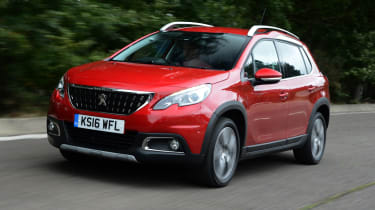
There are few classes of car packed with more choice today than the compact crossover and SUV segment. Pretty much every mainstream manufacturer offers something for this growing market, so standing out is devilishly hard. Those looking for style, quality and a tidy drive could do much worse than the Peugeot 2008. In several ways it’s class-leading, and many will welcome the option of an all-electric version, but crucially it’s not as practical as some rivals. High starting prices will be a further sticking point for customers seeking the best value.
About the Peugeot 2008
The second-generation version of Peugeot’s supermini-sized SUV arrived to great acclaim in 2019, with improvements across the board in design, technology and quality.
Not that we didn’t like the 2008 Mk1, which was something of a turning point in terms of Peugeot’s approach, being nice to drive, pleasant to sit in and very practical. However the latest version raised the bar again, with a terrific new design – the 2008 is especially eye-catching inside the cabin – and levels of fit and finish that would satisfy a quality control inspector at BMW or Audi.
There’s much to recommend the way the 2008 goes about its business too, largely due to the fact that it’s engineered using the Stellantis brand’s latest CMP small-car platform. The same tech now underpins a raft of Stellantis group products, including the Peugeot 208, Citroen C4 and DS 3 (formerly the DS 3 Crossback), not to mention the latest Vauxhall Mokka. Despite the Mk2 2008 being 141mm longer than its predecessor, it has a more rigid structure and barely adds any weight.
Peugeot has slimmed down the 2008’s engine range recently, dropping increasingly out-of-favour diesel power for a choice of either petrol or electric drivetrains. Petrol power is available in the form of the 1.2-litre PureTech unit, offered in two states of tune and with a choice of two transmissions, depending on the power output. The lower-power variant produces 99bhp with a six-speed manual gearbox, while the top petrol is now the 128bhp unit, available with either the manual or an eight-speed automatic.
Each of the lively petrol units offers good economy, but the other option promises even lower running costs. The e-2008 is the all-electric model in the range, with an official range of 214 miles, and a smoother, quieter, and brisker driving experience than any of the fossil fuel alternatives.
More reviews
Car group tests
In-depth reviews
Road tests
Used car tests
Choose petrol or the all-electric powertrain and then there’s a choice of three trim levels running from an entry-level Active Premium+, to Allure Premium+, with GT topping the range. All trims are available with both PureTech petrol power, and in full electric form; Active Premium+ only gets the lower-power petrol and the EV, while the GT’s petrol engine is the higher-power unit in auto or manual.
All models come with the Peugeot i-Cockpit digital dash and a 7-inch touchscreen with Apple CarPlay and Android Auto, DAB radio, smartphone docking and voice recognition amongst the goodies on the standard spec list. Allure Premium models get Active Safety Braking while GT models get a 10-inch touchscreen upgrade. GT has flashy 18-inch diamond-cut alloys (Active Premium+ gets 16-inch alloys, the Allure Premium+ 17-inch wheels), plus adaptive cruise control and Alcantara trim.
While the pros generally outweigh the cons, there is one big stumbling block that prevents the Peugeot 2008 from competing with the class best: price. While you could argue that the build quality justifies the extra expense over many mainstream rivals, that argument falls flat against competition such as the Renault Captur. The Renault feels almost as posh inside and is a little more comfy and refined, yet similarly specced versions cost roughly £1,500 less than the Peugeot. It’s worth noting though that the latest Vauxhall Mokka – the 2008’s twin-under-the-skin thanks to its shared Stellantis platform – also attracts a similar price premium compared to many rivals.
Other options in the segment include the practical, comfortable Skoda Kamiq and the sporty, tech-laden Ford Puma. The lengthy list of other alternatives facing buyers in this sector also includes the less pricey Citroen C3 Aircross and Dacia Duster. You could also go for Fiat’s 500X or Kia’s Stonic, the Honda HR-V, MINI Countryman, Nissan Juke, Seat Arona and Volkswagen T-Cross, plus quite a few others. The Hyundai Kona is another strong contender in this segment, with an all-new model due to arrive in 2023.
Used and nearly new
The Peugeot 2008’s timeline starts in 2013, when the first-gen version was introduced around a year after the Peugeot 208 supermini that it’s closely related to first went on sale. Across both generations of Peugeot 2008 to date, the car has offered a blend of sharp styling, agile handling and a comfortable ride. The Peugeot 2008 Mk2 saw the small SUV move further upmarket than its predecessor, which while giving the car a more premium feel also made it a pricier buy.
Peugeot 2008 history

Peugeot 2008 Mk2: 2019-present
The second-generation Peugeot 2008 Mk2 built upon the foundations of its predecessor: practicality and interior build quality were improved, and the looks were more striking this time around. Like the Mk1 model, the Peugeot 2008 Mk2 had close ties to the Peugeot 208, so the two cars featured similar interior tech and features. The powertrain options were similar, too, consisting of petrol and diesel engines and – for the first time ever in a Peugeot 2008 – a pure-electric option.

Peugeot 2008 Mk1: 2013-2019
The Peugeot 2008 Mk1 went on sale in 2013, and was billed as the higher-riding equivalent of the Peugeot 208 Mk1 urban runabout. While a lot of tech was shared between the cars, the 2008 Mk1 was bigger and more spacious than the 208, and came with a bit more equipment as standard to reflect its slightly higher list price. Engine options consisted of a variety of petrol and diesel engines, and all Peugeot 2008 Mk1s were only available with front-wheel drive. Read our full Mk1 Peugeot 2008 buyer’s guide here…
For an alternative review of the Peugeot 2008, visit our sister site carbuyer.co.uk…





